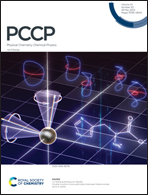On the relationship between the Debye process in dielectric response and a dissociation–association phenomenon in phenyl alcohols†
Abstract
In this paper, we have examined a series of phenyl-substituted primary monohydroxy alcohols (phenyl alcohols, PhAs), from ethanol to hexanol by means of dielectric and Fourier transform infrared (FTIR) spectroscopies supported by the mechanical investigations. The combination of both dielectric and mechanical data allows calculation of the energy barrier, Ea, for dissociation by the Rubinstein approach developed to describe the dynamical properties of self-assembling macromolecules. It was observed that the determined activation energy remains constant, |Ea,RM| ∼ 12.9–14.2 kJ mol−1, regardless of the molecular weight of the examined material. Surprisingly, the obtained values agree very well with Ea of the dissociation process determined from the FTIR data analysed within the van’t Hoff relationship, where Ea,vH ∼ 9.13–13.64 kJ mol−1. Thus, the observed agreement between Ea determined by both applied approaches clearly implies that in the case of the examined series of PhAs, the dielectric Debye-like process is governed by the association–dissociation phenomenon as proposed by the transient chain model.



 Please wait while we load your content...
Please wait while we load your content...